SUB FACTS


Illustration courtesy Acheron Project Pty Ltd
DEEPSEA CHALLENGER
Editor’s note: On March 26, 2012, James Cameron made a record-breaking solo dive to the Earth’s deepest point, successfully piloting the DEEPSEA CHALLENGER nearly 7 seven miles (11 kilometers) to the Challenger Deep in the Mariana Trench. DEEPSEA CHALLENGE is now in its second phase—scientific analysis of the expedition’s findings. Click here for news about the historic dive, an exclusive postdive interview with Cameron, and information about the next phase of the expedition.
- The pilot is descending about 36,000 feet (10,973 meters), but his ears won’t pop during the journey; the pressure inside the pilot’s sphere stays constant.
- Crammed with equipment and just 43 inches (109 centimeters) wide, the interior of the pilot sphere is so small that the pilot will have to keep his knees bent and can barely move.
- Just like a car, the sub is equipped with “cruise control” so the pilot can hover exactly where he wants to or glide through the water at a constant speed.
- Water vapor from the pilot’s breath and sweat condenses on the cold metal sphere and drains to a space where it’s sucked into a plastic bag. In an emergency, the pilot can drink it.
- The pilot chamber is a sphere because it’s the strongest shape for resisting pressure—if the pilot sat in a cylinder, the walls would need to be three times thicker.
- The sub’s giant beam of syntactic foam shrinks about 2.5 inches (6.4 centimeters) under the immense water pressure at the ocean’s bottom.
- While the sub appears to be one streamlined vessel, the sphere is attached to the foam beam by polyester straps.
- If the sub’s 1,100 pounds (500 kilograms) of ballast weights don’t drop when commanded, a back-up galvanic release will corrode in the seawater within a fixed period of time, freeing the sub to rise to the surface.
- Small “bladders” inside the oil-filled external battery boxes will take in seawater. These “compensation bladders,” made from medical drip bags, are a critical part of the deep-ocean electronics system because the oil compresses at depth.
- The submersible will spin slowly as it descends and ascends. It’s engineered to do this so it doesn’t veer off track.
- The sub’s batteries are made up of over a thousand pouch-type lithium-ion cells, bigger versions of the batteries hobbyists use for model airplanes.
- More than 180 systems—from battery packs to sonar—will be operating during the dive.
- Every circuit board in the sub’s exterior electronics—over 1,500 of them—was designed and built specially for this vehicle.
- The sub’s four external cameras are a tenth the size of previous deep-ocean HD cameras. The housings were designed by the DEEPSEA CHALLENGE team, and the cameras themselves were created from scratch, from the sensor up.



